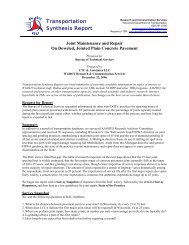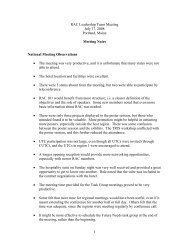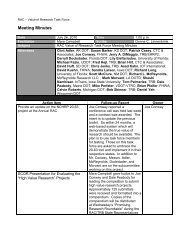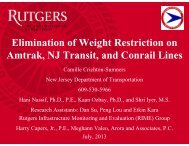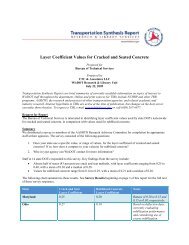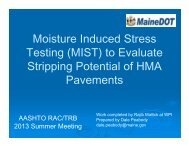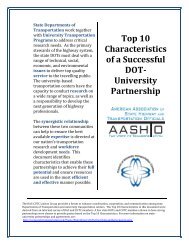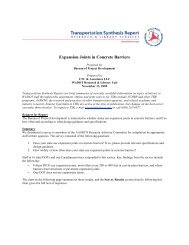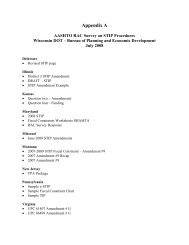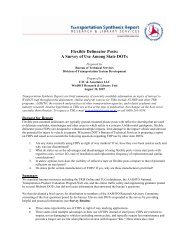PART IV: Summary of Comments - SCOR/RAC
PART IV: Summary of Comments - SCOR/RAC
PART IV: Summary of Comments - SCOR/RAC
Create successful ePaper yourself
Turn your PDF publications into a flip-book with our unique Google optimized e-Paper software.
<strong>PART</strong> <strong>IV</strong>: <strong>Summary</strong> <strong>of</strong> <strong>Comments</strong>17-May-10Reviewer <strong>Comments</strong> Distribution <strong>of</strong> Ratingsdepartment.■ Rewrite <strong>of</strong> the proposal seems appropriate.■ The authors fail to cite NCHRP report 577 with is a comprehensive work in this area and lays the groundwork for newresearch. Field studies to determine long term impacts to aquatic organism from the use <strong>of</strong> deicers is needed.■ Transportation Agencies have done a lot to reduce the amount <strong>of</strong> De-Icing material being applied with the advancementin equipment, implementing reduction strategies, use <strong>of</strong> anti-icing programs. Much research has already been performedlooking at the environmental impacts <strong>of</strong> these materials. Research should focus on ways to buffer sensitive areas fromthese various de-icing materials.■ Solid interest from Wisconsin, but not certain whether this is truly a national study … suggest that the Clear Roadspooled fund examine this study.Other■ [Rating: 3]■ [Rating: 4] Maintaining optimal water quality in water bodies while maintaining safe highways is a top priority for alltransportation agencies. Chemical deicers and sanding compounds can compromise water quality if not appliedcorrectly. The Committee acknowledges that the 2007 NCHRP report 577 investigates this topic. The members feel thatthe study was not comprehensive enough to assist the DOTs in make decisions regarding deicing materials. NOAA wasconsulted regarding this topic and they support the effort. The Committee suggests that the study should also includecost effectiveness as a component <strong>of</strong> the effort. A matrix should be developed highlighting the environmental effectsversus the cost component. This statement is on the committee's second tier <strong>of</strong> top priorities.Item #80:D-08Development <strong>of</strong> an Accurate Mathematical Model forPredicting Alaki Silica Reaction Damage in Concrete.(17)(46)NR 0 1 2 3 4 5<strong>SCOR</strong> 2 6 4 3 2<strong>RAC</strong> 2 7 5 12 9 8 6Standing Committee on Research■ The premise on which the proposal is based is misdirected. The formula for expressing the alkali content <strong>of</strong> cement isnot the reason for the problems the agency has experienced. It has a sound chemical basis and works fairly well withinbounds.The agency's problems suggest that the amount <strong>of</strong> alkali in concrete they accepted as tolerable was simply toohigh. Nonetheless, there are issues related to the alkalies in hydraulic cements that would be worth investigating. Thatsaid, that the problem geerating this proposal has occurred amidst the FHWA research program raises a cuationary noteand the need to proceed circumspectly.■ Some available tools are not mentioned problem statement■ <strong>of</strong> possible interest to concrete tie manufactuirng work■ We are not sure if a formula can be developed to cope with blended cements.■ Many states are dealing with the ASR issue in their concrete. The revelation by TxDOT justifies further research in thisarea. This is truly a national concern.■ [Rating: 5] The research as outlined in the problem statement will further enhance our fundamental understanding <strong>of</strong>ASR issues. The observed ASR in airfields due to potassium acetate as deicers is better understood now due to somepreliminary research data in objective 1 <strong>of</strong> FHWA ongoing research effort. It appears that as concentration <strong>of</strong> potassiumacetate is increased, hydroxyl activity increases drastically while the concentration <strong>of</strong> the hydroxyl ions remainsessentially constant.Research Advisory Committee■ This will help in developing better testing and evaluation tool for ASR potential aggregates. Also help determine if our<strong>IV</strong>-57



